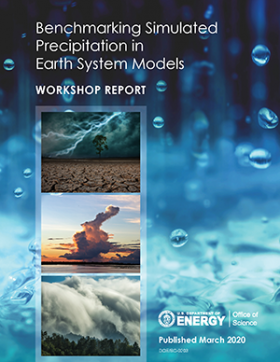Benchmarking Simulated Precipitation in Earth System Models
Earth system models (ESMs) bridge observationally based and theoretical understanding of the Earth system. They are among the best tools to study a variety of questions related to variability and changes in the Earth’s climate. ESMs realistically simulate observed large-scale precipitation patterns and seasonal cycles that have a multitude of societal and national security implications.
Despite steady improvement in the simulation of precipitation characteristics, persistent errors in several aspects of simulated precipitation preclude higher confidence in using ESMs to understand earth system variability and change and to make decisions.
In July 2019, the Regional and Global Model Analysis (RGMA) Program Area within the Earth and Environmental Systems Modeling (EESM) Program in the Climate and Environmental Sciences Division at the U.S. Department of Energy (DOE) led a two-day Precipitation Metrics Workshop, led by DOE Program Manager Renu Joseph and co-chaired by Peter Gleckler of Lawrence Livermore National Laboratory, Angeline Pendergrass of the National Center for Atmospheric Research (NCAR), and Ruby Leung of Pacific Northwest National Laboratory.
A diverse group of experts participated in the workshop, including model developers, observational experts, scientists with expertise in diagnosing or evaluating simulated precipitation and related processes, and several with experience in objectively summarizing model performance with metrics. Among others, they represented the National Aeronautics and Space Administration (NASA), National Oceanic and Atmospheric Administration (NOAA), DOE national laboratories, and universities.
The impetus for the workshop: Improve modeled precipitation by designing a capability to comprehensively evaluate ESMs—a capability that will help ESM developers better understand their models, providing them with quantitative targets for demonstrating model improvements. Two main thrusts drove the workshop dialogue:
- identify a holistic set of observed rainfall characteristics that could be used to define metrics to gauge the consistency between ESMs and observations
- assess state-of-the-science methods used to evaluate simulated rainfall and identify areas of research for exploratory metrics for improved understanding of model biases and meeting stakeholder needs.

